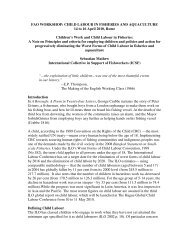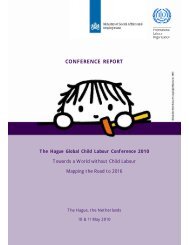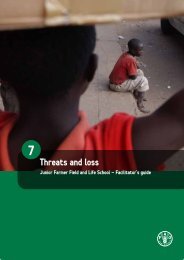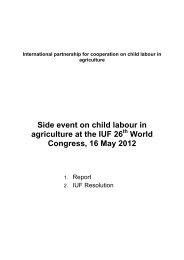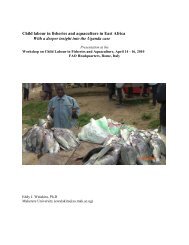Mainstreaming responses to the girl child in agriculture - Food ...
Mainstreaming responses to the girl child in agriculture - Food ...
Mainstreaming responses to the girl child in agriculture - Food ...
You also want an ePaper? Increase the reach of your titles
YUMPU automatically turns print PDFs into web optimized ePapers that Google loves.
<strong>to</strong> less labour <strong>in</strong>tensive crops will affect casual employment of boys and <strong>girl</strong>s<br />
differently How is this likely <strong>to</strong> affect rural employment overall<br />
- How will growth led by <strong>in</strong>creases <strong>in</strong> labour productivity, (as opposed <strong>to</strong> be<strong>in</strong>g<br />
driven only by technical fac<strong>to</strong>rs and <strong>in</strong>puts) <strong>in</strong>crease employment, and reduce or<br />
<strong>in</strong>crease <strong>child</strong> labour<br />
- Will <strong>the</strong> encouragement of technological <strong>in</strong>novations for poorer households have<br />
direct benefits <strong>in</strong> reduc<strong>in</strong>g <strong>child</strong> domestic labour (for example free<strong>in</strong>g up <strong>girl</strong>s <strong>in</strong><br />
terms of <strong>the</strong>ir traditional tasks).<br />
However, ma<strong>in</strong>stream<strong>in</strong>g <strong>child</strong> labour <strong>responses</strong> from a <strong>to</strong>p down perspective<br />
alone will be impossible due <strong>to</strong> <strong>the</strong> cross-cutt<strong>in</strong>g nature and challenge of <strong>the</strong> <strong>child</strong><br />
labour <strong>in</strong> <strong>agriculture</strong>. Once legislative bodies have set <strong>child</strong> labour standards, rural<br />
communities and enterprises are expected <strong>to</strong> accept <strong>the</strong>se standards. Judicial and<br />
regula<strong>to</strong>ry bodies are expected <strong>to</strong> moni<strong>to</strong>r <strong>the</strong> performance of agricultural supply cha<strong>in</strong>s<br />
<strong>in</strong> meet<strong>in</strong>g those standards, even if such bodies are not conv<strong>in</strong>ced, or supply cha<strong>in</strong>s are<br />
difficult <strong>to</strong> follow due <strong>to</strong> family farm production. In many cases, <strong>child</strong> labour standards<br />
<strong>in</strong> <strong>agriculture</strong> are no<strong>to</strong>riously difficult <strong>to</strong> moni<strong>to</strong>r because much <strong>child</strong> labour <strong>in</strong><br />
<strong>agriculture</strong> is on family farms and domestic work <strong>in</strong> rural areas is hidden. A fur<strong>the</strong>r<br />
problem is that women and <strong>girl</strong>s’ role <strong>in</strong> <strong>agriculture</strong> production is much wider than<br />
generally recognised by extension services, who are predom<strong>in</strong>antly run by and<br />
composed of men.<br />
Such a <strong>to</strong>p-down approach is also very bureaucratic and can ignore <strong>the</strong> causes and<br />
consequences of <strong>child</strong> labour <strong>in</strong> <strong>agriculture</strong>, most notably poverty and <strong>the</strong> value placed<br />
on education or on <strong>the</strong> <strong>girl</strong> <strong>child</strong>. The hardest <strong>to</strong> reach boys and <strong>girl</strong>s will always be<br />
most excluded. In any case, many field programmes <strong>in</strong>dicate that parents may view <strong>the</strong>ir<br />
<strong>girl</strong>s and boys differently and can have different values around <strong>girl</strong>s and boys need for<br />
education. In such scenarios, <strong>the</strong> value systems of <strong>the</strong> parents and guardians of <strong>child</strong><br />
labourers will perpetuate <strong>the</strong> problem. Thus sensitisation on <strong>the</strong> hazards of <strong>child</strong> labour,<br />
<strong>the</strong> importance of education, and gender equality must take place at <strong>the</strong> community and<br />
district levels.<br />
4.3 Child labour, adult employment and poverty reduction<br />
In 2008, <strong>the</strong> ILO’s report on <strong>the</strong> promotion of rural employment for poverty reduction<br />
states that <strong>the</strong> prevalence of rural <strong>child</strong> labour, especially <strong>in</strong> <strong>agriculture</strong>, underm<strong>in</strong>es<br />
decent work and employment for adults and weakens rural labour markets as it<br />
ma<strong>in</strong>ta<strong>in</strong>s a cycle where household <strong>in</strong>come for both farmers and waged workers is<br />
<strong>in</strong>sufficient <strong>to</strong> meet <strong>the</strong> economic needs of <strong>the</strong>ir families. The report also adds that <strong>child</strong><br />
labour underm<strong>in</strong>es efforts <strong>to</strong> promote rural youth employment under decent conditions<br />
of work, because older <strong>child</strong>ren must cont<strong>in</strong>ue <strong>to</strong> work <strong>in</strong> exploitative conditions, with<br />
poor future job and economic prospects. It is now widely acknowledged that <strong>child</strong><br />
labour cannot be tackled <strong>in</strong> isolation from address<strong>in</strong>g <strong>the</strong> problem of end<strong>in</strong>g rural<br />
poverty” (ILO, 2008).<br />
While economic growth and stability are necessary for poverty reduction, o<strong>the</strong>rs<br />
argue that economic growth is not a panacea for a reduction <strong>in</strong> <strong>child</strong> labour<br />
U. Murray, P. Hurst - Draft for discussion - 14






